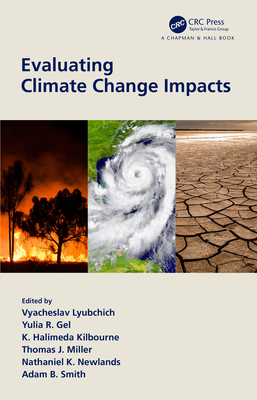Machine Learning Methods in the Environmental Sciences: Neural Networks and Kernels
William W. Hsieh
- 出版商: Cambridge
- 出版日期: 2018-03-01
- 定價: $1,420
- 售價: 9.0 折 $1,278
- 語言: 英文
- 頁數: 363
- 裝訂: Paperback
- ISBN: 1108456901
- ISBN-13: 9781108456906
-
相關分類:
Machine Learning
立即出貨 (庫存=1)
買這商品的人也買了...
-
 $1,188Fedora 11 and Red Hat Enterprise Linux Bible (Paperback)
$1,188Fedora 11 and Red Hat Enterprise Linux Bible (Paperback) -
 離散數學 最新修訂版
離散數學 最新修訂版$800$632 -
 Python 設計模式深入解析 (Mastering Python Design Patterns)
Python 設計模式深入解析 (Mastering Python Design Patterns)$360$281 -
 A First Course in Graph Theory (Paperback)
A First Course in Graph Theory (Paperback)$1,200$1,140 -
 不再聽不懂!圖解網站建置與開發
不再聽不懂!圖解網站建置與開發$450$356 -
 Python 函式庫語法範例字典
Python 函式庫語法範例字典$450$356 -
 演算法之美:隱藏在資料結構背後的原理 (C++版)
演算法之美:隱藏在資料結構背後的原理 (C++版)$650$507 -
 為你自己學 Git
為你自己學 Git$500$425 -
 Density Ratio Estimation in Machine Learning
Density Ratio Estimation in Machine Learning$2,120$2,014 -
 Python 技術者們 - 實踐! 帶你一步一腳印由初學到精通
Python 技術者們 - 實踐! 帶你一步一腳印由初學到精通$650$514 -
 Python 與 LINE Bot 機器人全面實戰特訓班 (附203分鐘影音教學/範例程式)
Python 與 LINE Bot 機器人全面實戰特訓班 (附203分鐘影音教學/範例程式)$520$411 -
 Python 技術者們 - 練功!老手帶路教你精通正宗 Python 程式 (The Quick Python Book, 3/e)
Python 技術者們 - 練功!老手帶路教你精通正宗 Python 程式 (The Quick Python Book, 3/e)$780$616 -
 設計師都該懂的包容性網頁 UI/UX 設計模式:知名設計師教你親和性網頁的實作祕密
設計師都該懂的包容性網頁 UI/UX 設計模式:知名設計師教你親和性網頁的實作祕密$450$351 -
 邁向 Linux 工程師之路:Superuser 一定要懂的技術與運用, 2/e (How Linux Works: What Every Superuser Should Know, 2/e)
邁向 Linux 工程師之路:Superuser 一定要懂的技術與運用, 2/e (How Linux Works: What Every Superuser Should Know, 2/e)$600$468 -
 JavaScript 技術手冊
JavaScript 技術手冊$560$420 -
 PowerShell 流程自動化攻略 (Powershell for Sysadmins: A Hands-On Guide to Automating Your Workflow)
PowerShell 流程自動化攻略 (Powershell for Sysadmins: A Hands-On Guide to Automating Your Workflow)$500$395 -
 精通資料視覺化 : 用試算表與程式說故事 (Hands-On Data Visualization: Interactive Storytelling from Spreadsheets to Code)
精通資料視覺化 : 用試算表與程式說故事 (Hands-On Data Visualization: Interactive Storytelling from Spreadsheets to Code)$680$537 -
 打下最紮實 AI 基礎不依賴套件:手刻機器學習神經網路穩健前進
打下最紮實 AI 基礎不依賴套件:手刻機器學習神經網路穩健前進$1,200$948 -
 $3,383Graph Neural Networks: Foundations, Frontiers, and Applications (Hardcover)
$3,383Graph Neural Networks: Foundations, Frontiers, and Applications (Hardcover) -
 強健的 Python|撰寫潔淨且可維護的程式碼 (Robust Python: Write Clean and Maintainable Code)
強健的 Python|撰寫潔淨且可維護的程式碼 (Robust Python: Write Clean and Maintainable Code)$680$537 -
 Template Metaprogramming with C++: Learn everything about C++ templates and unlock the power of template metaprogramming (Paperback)
Template Metaprogramming with C++: Learn everything about C++ templates and unlock the power of template metaprogramming (Paperback)$1,900$1,805 -
 邁向 Linux 工程師之路:Superuser 一定要懂的技術與運用, 3/e (How Linux Works : What Every Superuser Should Know, 3/e)
邁向 Linux 工程師之路:Superuser 一定要懂的技術與運用, 3/e (How Linux Works : What Every Superuser Should Know, 3/e)$780$608 -
 精通無瑕程式碼:工程師也能斷捨離!消除複雜度、提升效率的 17個關鍵技法 (The Art of Clean Code: Best Practices to Eliminate Complexity and Simplify Your Life)
精通無瑕程式碼:工程師也能斷捨離!消除複雜度、提升效率的 17個關鍵技法 (The Art of Clean Code: Best Practices to Eliminate Complexity and Simplify Your Life)$600$468 -
 演算法觀點的圖論 (修訂版)
演算法觀點的圖論 (修訂版)$650$585 -
 Deep Learning: Foundations and Concepts (Hardcover)
Deep Learning: Foundations and Concepts (Hardcover)$3,480$3,306
商品描述
Machine learning methods originated from artificial intelligence and are now used in various fields in environmental sciences today. This is the first single-authored textbook providing a unified treatment of machine learning methods and their applications in the environmental sciences. Due to their powerful nonlinear modeling capability, machine learning methods today are used in satellite data processing, general circulation models(GCM), weather and climate prediction, air quality forecasting, analysis and modeling of environmental data, oceanographic and hydrological forecasting, ecological modeling, and monitoring of snow, ice and forests. The book includes end-of-chapter review questions and an appendix listing web sites for downloading computer code and data sources. A resources website containing datasets for exercises, and password-protected solutions are available. The book is suitable for first-year graduate students and advanced undergraduates. It is also valuable for researchers and practitioners in environmental sciences interested in applying these new methods to their own work.
Preface Excerpt
Machine learning is a major subfield in computational intelligence (also called artificial intelligence). Its main objective is to use computational methods to extract information from data. Neural network methods, generally regarded as forming the first wave of breakthrough in machine learning, became popular in the late 1980s, while kernel methods arrived in a second wave in the second half of the 1990s. This is the first single-authored textbook to give a unified treatment of machine learning methods and their applications in the environmental sciences.
Machine learning methods began to infiltrate the environmental sciences in the 1990s. Today, thanks to their powerful nonlinear modeling capability, they are no longer an exotic fringe species, as they are heavily used in satellite data processing, in general circulation models (GCM), in weather and climate prediction, air quality forecasting, analysis and modeling of environmental data, oceanographic and hydrological forecasting, ecological modeling, and in the monitoring of snow, ice and forests, etc.
This book presents machine learning methods and their applications in the environmental sciences (including satellite remote sensing, atmospheric science, climate science, oceanography, hydrology and ecology), written at a level suitable for beginning graduate students and advanced undergraduates. It is also valuable for researchers and practitioners in environmental sciences interested in applying these new methods to their own work.
Chapters 1-3, intended mainly as background material for students, cover the standard statistical methods used in environmental sciences. The machine learning methods of chapters 4-12 provide powerful nonlinear generalizations for many of these standard linear statistical methods. End-of-chapter review questions are included, allowing readers to develop their problem-solving skills and monitor their understanding of the material presented. An appendix lists websites available for downloading computer code and data sources. A resources website is available containing datasets for exercises, and additional material to keep the book completely up-to-date.
About the Author
WILLIAM W. HSIEH is a Professor in the Department of Earth and Ocean Sciences and in the Department of Physics and Astronomy, as well as Chair of the Atmospheric Science Programme, at the University of British Columbia. He is internationally known for his pioneering work in developing and applying machine learning methods in environmental sciences. He has published over 80 peer-reviewed journal publications covering areas of climate variability, machine learning, oceanography, atmospheric science and hydrology.










